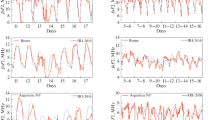Abstract
In this paper, we have analyzed how the change in the solar activity is able to affect the IRI-2016 outcomes for different latitudes. We have compared the IRI-2016 model predictions with F2 layer critical frequency (foF2) data derived from the low (Manila), middle (Rome and Kiev) and high (Sodankyla) latitude ionosonde stations during high (1980) and low (1986) solar activity periods. In order to test the performance of IRI-2016, we have calculated the root mean square errors (RMSE) during both low and high solar activity periods. The results show that the deviation between the IRI-2016 predictions and the foF2 measurements are the largest for high solar activity period and this deviation varies depending on the seasons, latitudes, and local time. The IRI-2016 model predictions during low solar activity period usually provide better agreement with the observations at all latitudes. The IRI-2016 performance during high solar activity period changes considerably depending on the seasons and local time at low and high latitudes. During high solar activity period, the discrepancy in IRI-2016 predictions at low and high latitudes is found to be larger and more significant than that at mid-latitude region, particularly for winter and equinox seasons. The results show that the last version of the IRI model is not sufficient to properly represent the real conditions of high solar activity and the IRI-2016 model still needs to significant improvements particularly in the low and high latitude regions taking the impacts of solar maximum year into account.








Similar content being viewed by others
REFERENCES
Adebesin, B.O., Adekoya, B.J., Ikubanni, S.O., Adebiyi, S.J., Adebesin, O.A., Joshua, B.W., and Olonade, K.O., Ionospheric foF2 morphology and response of F2 layer height over Jicamarca during different solar epochs and comparison with IRI-2012 model, J. Earth Syst. Sci., 2014, vol. 123, pp. 751–765.
Arikan, F., Sezen, U., and Gulyaeva, T.L., Comparison of IRI-2016 layer model parameters with ionosonde measurements, J. Geophys. Res.: Space Phys., 2019, vol. 124, pp. 8092–8109.
Bertoni, F., Sahai, Y., Lima, W.L.C., Fagundes, P.R., Pillat, V.G., Guedes, B.F., and Abalde, J.R., IRI-2001 model predictions compared with ionospheric data observed at Brazilian low latitude stations, Ann. Geophys., 2006, vol. 24, pp. 2191–2200.
Bilitza, D., International Reference Ionosphere: Status 1995/96, Adv. Space Res., 1997, vol. 20, pp. 1751–1754.
Bilitza, D., International Reference Ionosphere 2000, Radio Sci., 2001, vol. 36, pp. 261–275.
Bilitza, D., The International Reference Ionosphere: Rawer’s IRI and its status today, Adv. Radio Sci., 2014, vol. 12, pp. 231–236.
Bilitza, D. and Reinisch, B.W., International Reference Ionosphere 2007: Improvements and new parameters, Adv. Space Res., 2008, vol. 42, pp. 599–609.
Bilitza, D., Altadill, D., Truhlik, V., Shubin, V., Galkin, I., Reinisch, B., and Huang, X., International Reference Ionosphere 2016: From ionospheric climate to real-time weather predictions, Space Weather, 2017, vol. 15, pp. 418–429.
Chuo, Y.J., Variations of ionospheric profile parameters during solar maximum and comparison with IRI-2007 over Chung-Li, Taiwan, Ann. Geophys., 2012, vol. 30, pp. 1249–1257.
Clette, F., Svalgaard, L., Vaquero, J.M., and Cliver, E.W., Revisiting the sunspot number—A 400-year perspective on the solar cycle, Space Sci. Rev., 2014, vol. 186, pp. 35–103.
Danilov, A.D. and Laštovička, J., Effects of geomagnetic storms on the ionosphere and atmosphere, Int. J. Geomagn. Aeron., 2001, vol. 3, pp. 209–224.
Kalita, B.R. and Bhuyan, P.K., Variations of the ionospheric parameters and vertical electron density distribution at the northern edge of the EIA from 2010 to 2015 along 95° E and comparison with the IRI-2012, Adv. Space Res., 2017, vol. 60, pp. 295–306.
Kumar, S., Tan, E.L., and Murti, D.S., Impacts of solar activity on performance of the IRI-2012 model predictions from low to mid latitudes, Earth Planets Space, 2015, vol. 67, pp. 1–17.
Liu, Z., Fang, H., Weng, L., Wang, S., Niu, J., and Meng, X., A comparison of ionosonde measured foF2 and IRI-2016 predictions over China, Adv. Space Res., 2019, vol. 63, pp. 1926–1936.
Lühr, H. and Xiong, C., IRI-2007 model overestimates electron density during the 23/24 solar minimum, Geophys. Res. Lett., 2010, vol. 37, L23101.
Prölss, G.W., Physics of the Earth’s Space Environment, Berlin: Springer, 2004, pp. 77–444.
Rao, S.S., Chakraborty, M., and Pandey, R., Ionospheric variations over Chinese EIA region using foF2 and comparison with IRI-2016 model, Adv. Space Res., 2018, vol. 62, pp. 84–93.
Schunk, R.W. and Nagy, A.F., Ionospheres: Physics, Plasma Physics, and Chemistry, Cambridge University Press, 2000, pp. 366–432.
Sethi, N.K., Dabas, R.S., and Ninawe, Y., foF2 variability over New Delhi during different solar cycle conditions and comparison with IRI-2001 model, Adv. Space Res., 2007, vol. 40, pp. 855–860.
Timoçin, E., Ünal, İ., Tulunay, Y., and Göker, Ü.D., The effect of geomagnetic activity changes on the ionospheric critical frequencies (foF2) at magnetic conjugate points, Adv. Space Res., 2018a, vol. 62, pp. 821–828.
Timoçin, E., Ünal, İ., and Göker, Ü.D., A comparison of IRI-2016 foF2 predictions with the observations at different latitudes during geomagnetic storms, Int. J. Geomagn. Aeron., 2018b, vol. 58, pp. 846–856.
Zakharenkova, I.E., Krankowski, A., Bilitza, D., Cherniak, I.V., Shagimuratov, I.I., and Sieradzki, R., Comparative study of foF2 measurements with IRI-2007 model predictions during extended solar minimum, Adv. Space Res., 2013, vol. 51, pp. 620–629.
Author information
Authors and Affiliations
Corresponding authors
Rights and permissions
About this article
Cite this article
Timoçin, E., Temuçin, H. Comparative of foF2 Measurements with IRI-2016 Model Predictions for Different Latitudes during Low and High Solar Activity. Geomagn. Aeron. 61, 438–448 (2021). https://doi.org/10.1134/S0016793221030166
Received:
Revised:
Accepted:
Published:
Issue Date:
DOI: https://doi.org/10.1134/S0016793221030166




